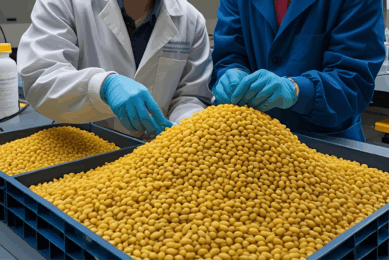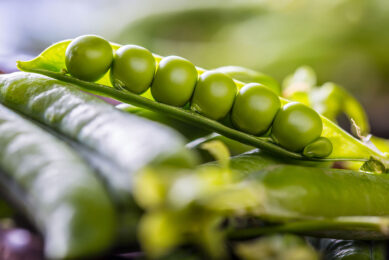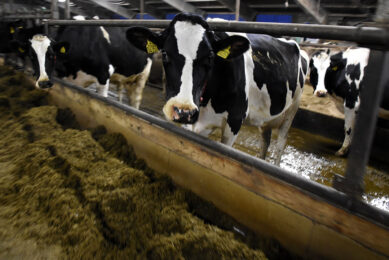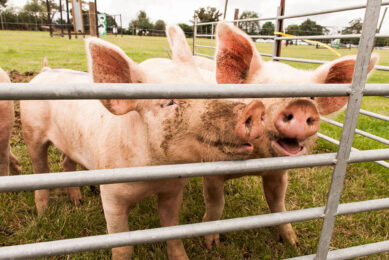The potential of lupins as a soy alternative

Examining the potential for this high-protein crop to replace soybean meal in the ration of various livestock species.
Soybean meal (SBM) is currently the most common protein component in compound feed for pigs, poultry and dairy cattle in Europe and many other regions around the the globe. However, because the price of SBM fluctuates and because soybean production in some parts of the world involves significant sustainability concerns, there is active investigation of crops that can serve as full or partial replacements.
In a report on the ‘Use of Lupin as a Source of Protein in Animal Feeding: Genomic Tools and Breeding Approaches’, scientists based in Greece note that lupin “could be a realistic sustainable alternative source of protein for animal feeding.” Indeed, for centuries lupins (a pulse crop) have been grown for feed and food in many areas of the world, mainly the Mediterranean and some parts of South America.
Species of lupin
Although there are many species, the main ones now cultivated are:
- Lupinus albus (white flower)
- L. angustifolius (blue)
- L. luteus (yellow)
Uses of Lupin
Almost all lupin is grown for feed. For hundreds of years, farmers have found lupins useful in grain crop rotation to control weeds and pests and improve soil fertility and crop yields through their ability to fix nitrogen, according to Dr Steve Little in a 2021 report for the Australian Export Grains Innovation Centre. In Australia, lupins also break up the hard pan in the soil profile caused by tillage. The state of Western Australia accounts for more than 72% of global lupin production. Other regions and countries with considerable lupin acreage are Eastern Europe, the Mediterranean, probably Russia (difficult to confirm), Chile and Canada.
Lupin as feed
Duncan Rowland, Executive Officer at the Stock Feed Manufacturers’ Council of Australia, notes that lupins have been used in livestock feed there for many years, mainly for dairy cattle but also for beef cattle and pigs. Dairy farmers and farmers with small beef feedlots grow their own lupin. Lupins are also used in Australia in horse feed, says Rowland, mostly as a micronised high-value bagged product. Lupins can also serve as a pasture supplement for sheep in Australia.
Anthracnose disease
Rowland adds that many problems with anthracnose disease about 20 years ago caused a decrease in lupin acreage in Australia, but breeding for resistance has enabled acreage to rise again. These anthracnose problems in the late 1990s/early 2000s also caused some shifts in the cultivation of varieties in Europe.
Nutritional value
Generally, lupins grains are characterised by high protein content with a low amount of high-quality oil (Table 1). They also contain some anti-nutritional compounds such as alkaloids,oligosaccharides, protease inhibitors, tannins and saponins. However, much breeding progress has been made to reduce these compounds in the grain, so much so that lupins are now being examined on a small scale as a serious plant-based protein ingredient for vegan food products.
In Canada, an L. albus variety called Dieta and an L. angustifolius variety called Boregine (both developed in Europe) have been registered by a company called Koralta Agri-Business. In 2021, it contracted growers to plant the crop in Manitoba and Saskatchewan, and it aims to cultivate about 40,000 acres in Western Canada by 2023. Dieta will initially be marketed for food and feed in the Middle East, while Boregine will initially be grown primarily for the feed market in Asia.
Dairy cows
Lupins are used extensively in the Australian dairy industry. Little notes that Australian varieties of L. angustifolius are highly suitable for ruminants, with their high digestibility and highly metabolisable energy value. “Most dairy studies comparing cows fed lupins versus grains in the milking parlour have found that lupins produced more milk, fat and protein,” states Little. “Milk protein concentrations tended to be reduced slightly. Dairy studies have found that substituting oilseed meals with lupins did not alter milk, fat and protein yields.” Lupins are also a very good source of rumen degradable protein, are low in starch and contain 6-10% oil, which is mostly unsaturated. Australian lupins are moderately high in neutral detergent fibre (unlike other legumes and cereal grains), so they don’t depress fibre digestion or voluntary feed intake. In addition, Little states that they are “easy to handle and store due to their low moisture level and a robust seed coat, which is impervious to insects.” For cattle consumption, lupins only need coarse rolling to reduce the particle size to 2-4.2 mm.
Pigs
In 2020, researchers in Poland published results showing that as a replacement for SBM, yellow lupin (L. luteus, Mister variety) in pig diets produced similar raw meat parameters. In addition, research conducted by scientists at the Department of Agriculture in Western Australia and Murdoch University has shown that current Australian varieties of L. angustifolius can replace all of the SBM in grower-finisher pig diets without compromising growth rate, carcass composition or meat quality when adequately fortified with some synthetic amino acids.
Poultry
Dr Gerhard Bellof at the Weihenstephan-Triesdorf University of Applied Sciences in Germany recently wrote a report called ‘Faba bean, grain pea, sweet lupin and soybean in poultry feeds’ for the ‘Union For The Promotion Of Oil And Protein Crops’ in Europe, with colleagues Dr Ingrid Halle and Dr Markus Rodehutscord. They found that the essential amino acids in lupins are as digestible as those in soy protein. “Combining other protein alternatives such as rapeseed meal and sunflower cake can contribute to a balanced amino acid supply,” they state in the report. “This means that soybean meal can be replaced entirely in laying hen feed. In complete feed mixtures for poultry fattening, the soybean meal content can be significantly reduced by deploying such combinations, at least in the final fattening stages.” Analysis by Czech scientists published in 2021 on lupin in laying hen diets found that “replacing soy protein with white lupin protein reduced cholesterol and triacylglycerides in blood plasma, and that feedstuff including white lupin protein did not negatively affect the health status of the layers.” With colleagues, Brian Kenyon, senior nutrition manager at ABN, recently conducted a study of lupins as a SBM replacement in broiler diets in the UK. They examined nutrition values for both blue and white lupin varieties and completed financial evaluations of lupins in comparison with conventional protein sources such as SBM, rapeseed, peas, field beans and sunflower meal. Kenyon states that “lupins could be used in poultry diets in the UK as an alternative to soy, but there needs to be significant improvement in production yields for the price to become viable for both arable farmers and feed producers.”
Fermentation effects
In Iceland, lupins are very widespread. In a new study at the University of Iceland, lupins are being analysed at various growth stages and also after fermentation. The plants will be fermented using various processes and potential products for human and/or livestock consumption will be developed.











